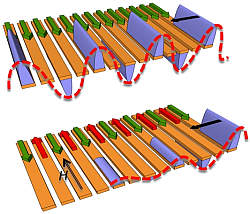Reprogrammable Control of Spin Wave Flow
Reprogrammable Control of Spin Wave Flow

Top: Sketch of a spin wave bound to magnetic nanowires and propagating in transverse direction in a one-dimensional magnonic crystal. The magnetization of all wires is in parallel.
Bottom: After ordering the wires in an anti-parallel configuration the spin wave is stopped via a small in-plane field.
A meta-material consisting of magnetic nanowires has been realized where the propagation of wave-like spin excitations is allowed or stopped depending on the magnetic state. This device forms a novel kind of artificial crystal where the dynamic response in the microwave frequency regime is reprogrammable.
Nanotechnology allows one to generate artificial materials with unforeseen physical properties, i.e., meta-materials. Using periodic arrangements of dielectric nanostructures, so-called artificial crystals have been shown to exist for electro-magnetic waves in the optical frequency regime. Such photonic crystals have led to unprecedented control of light-propagation on microchips and improved performance of optical devices. A collaborative work performed by the research group E10 of TU München and groups at the University of Hamburg and University of Western Australia has now shown that magnetic materials periodically patterned on the nanoscale form a novel kind of artificial crystal for collective spin excitations which can be reprogrammed. Due to the non-volatility of magnetic states the fabricated one-dimensional magnonic crystal has provided an enhanced level of control of GHz excitations propagating in magnetic solids. Such spin wave excitations have a wavelength on the nanoscale which is several orders of magnitude shorter than corresponding electromagnetic waves. Nanodevices are thus possible which are operating at microwave frequencies and offer multi-functionality in magnonic applications.
The research on magnonics performed by E10 at TU München is supported by the German Excellence Cluster Nanosystems Initiative Munich (NIM) and the European Community's Seventh Framework Programme (FP7/2007-2013) under Grant Agreement no. 228673 (MAGNONICS).
Further Information
Making a Reconfigurable Artificial Crystal by Ordering Bistable Magnetic Nanowires, Phys. Rev. Lett. (in press)
Further Information on magnonics will be provided also at "Lange Nacht der Wissenschaften” in the entrance hall of the Physics Department.
Contact
Prof. Dr. Dirk GrundlerPhysik-Department E10
Lehrstuhl für Physik funktionaler Schichtsysteme
Technische Universität München
James-Franck-Straße 1
85747 Garching
+49.89.289.12401
grundler@ph.tum.de